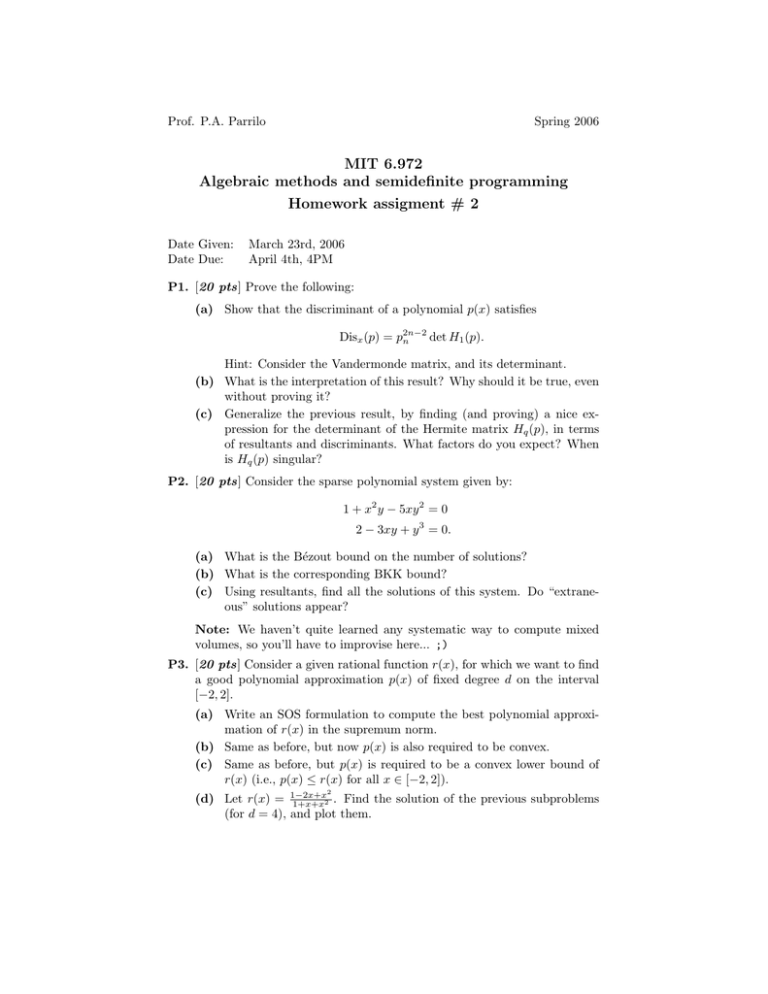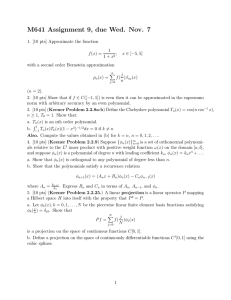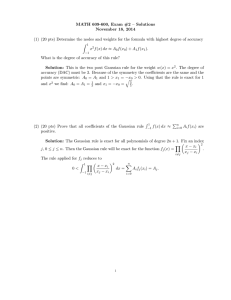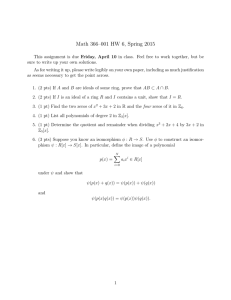MIT 6.972 Homework assigment # 2
advertisement

Prof. P.A. Parrilo Spring 2006 MIT 6.972 Algebraic methods and semidefinite programming Homework assigment # 2 Date Given: Date Due: March 23rd, 2006 April 4th, 4PM P1. [20 pts] Prove the following: (a) Show that the discriminant of a polynomial p(x) satisfies Disx (p) = p2n−2 det H1 (p). n Hint: Consider the Vandermonde matrix, and its determinant. (b) What is the interpretation of this result? Why should it be true, even without proving it? (c) Generalize the previous result, by finding (and proving) a nice ex­ pression for the determinant of the Hermite matrix Hq (p), in terms of resultants and discriminants. What factors do you expect? When is Hq (p) singular? P2. [20 pts] Consider the sparse polynomial system given by: 1 + x2 y − 5xy 2 = 0 2 − 3xy + y 3 = 0. (a) What is the Bézout bound on the number of solutions? (b) What is the corresponding BKK bound? (c) Using resultants, find all the solutions of this system. Do “extrane­ ous” solutions appear? Note: We haven’t quite learned any systematic way to compute mixed volumes, so you’ll have to improvise here... ;) P3. [20 pts] Consider a given rational function r(x), for which we want to find a good polynomial approximation p(x) of fixed degree d on the interval [−2, 2]. (a) Write an SOS formulation to compute the best polynomial approxi­ mation of r(x) in the supremum norm. (b) Same as before, but now p(x) is also required to be convex. (c) Same as before, but p(x) is required to be a convex lower bound of r(x) (i.e., p(x) ≤ r(x) for all x ∈ [−2, 2]). 2 (d) Let r(x) = 1−2x+x 1+x+x2 . Find the solution of the previous subproblems (for d = 4), and plot them. Prof. P.A. Parrilo Homework assigment # 2 (Page 2 of 2) Spring 2006 P4. [20 pts] Recall the procedure described in the lecture to recover a nonneg­ ative measure from its moments. (a) Prove that the procedure as described always produces a valid mea­ sure, provided the initial matrix of moments is positive definite. (b) Find a discrete measure having the same first eight moments as a standard normal distribution of zero mean and unit variance. (c) What does the previous result imply, if we are interested in computing integrals of the type � ∞ x2 1 √ p(x)e− 2 dx, 2π −∞ where p(x) is a polynomial of degree less than eight? What would you do if p(x) is an arbitrary (smooth) function? (d) Use these ideas to give an approximate numerical value of the definite integral � ∞ 2 cos(1 + x) e−3x dx −∞ How does your approximation compare with the true value? Note: In the general case where we are matching 2d moments, it can be shown that the√support of these discrete measures will be given by the d zeros of Hd (x/ 2), where Hd is the standard Hermite polynomial of degree d. Can you prove this? P5. [20 pts] In this exercise we describe a procedure to generalize Chebyshev­ type inequalities. For simplicity, we consider the univariate case; see the paper of Bertsimas and Popescu for extensions and more details. Consider a random variable X, with an unknown probability distribution supported on the set Ω, and for which we know its first d + 1 moments (µ0 , . . . , µd ). We want to find bounds on the probability of an event S ⊆ Ω, i.e., want to bound P (X ∈ S). We assume S and Ω are given intervals. Consider the following optimization problem in the decision variables ck : �� d d � ck xk ≥ 1 ∀x ∈ S min ck µk s.t. (1) �k=0 d k k=0 ck x ≥ 0 ∀x ∈ Ω. k=0 (a) Show that any feasible solution of (1) gives a valid upper bound on P (X ∈ S). How would you solve this problem? (b) Assume that Ω = [0, 5], S = [4, 5], and we know that the mean and variance of X are equal to 1 and 1/2, respectively. Give upper and lower bounds on P (X ∈ S). Are these bounds tight? Can you find the worst­case distributions?




